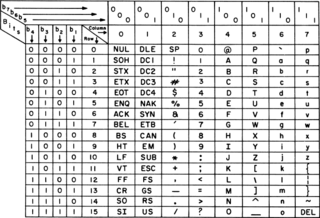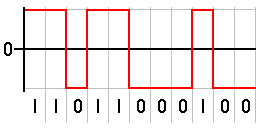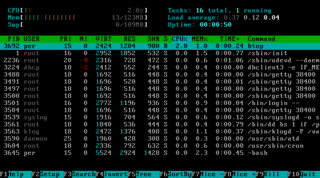DC-1 or DC1 may refer to:
- Douglas DC-1, an American airliner design
- Pirs (ISS module), also known as DC-1 (Docking Compartment 1)
- C0 and C1 control codes#DC1, computer control codes
DC-1 or DC1 may refer to:

ASCII, abbreviated from American Standard Code for Information Interchange, is a character encoding standard for electronic communication. ASCII codes represent text in computers, telecommunications equipment, and other devices. Most modern character-encoding schemes are based on ASCII, although they support many additional characters.
In computing and telecommunication, a control character or non-printing character (NPC) is a code point in a character set, that does not represent a written symbol. They are used as in-band signaling to cause effects other than the addition of a symbol to the text. All other characters are mainly printing, printable, or graphic characters, except perhaps for the "space" character.
CDC may refer to:
The Lightweight Directory Access Protocol is an open, vendor-neutral, industry standard application protocol for accessing and maintaining distributed directory information services over an Internet Protocol (IP) network. Directory services play an important role in developing intranet and Internet applications by allowing the sharing of information about users, systems, networks, services, and applications throughout the network. As examples, directory services may provide any organized set of records, often with a hierarchical structure, such as a corporate email directory. Similarly, a telephone directory is a list of subscribers with an address and a phone number.

In telecommunication, a non-return-to-zero (NRZ) line code is a binary code in which ones are represented by one significant condition, usually a positive voltage, while zeros are represented by some other significant condition, usually a negative voltage, with no other neutral or rest condition.

ANSI escape sequences are a standard for in-band signaling to control cursor location, color, font styling, and other options on video text terminals and terminal emulators. Certain sequences of bytes, most starting with an ASCII escape character and a bracket character, are embedded into text. The terminal interprets these sequences as commands, rather than text to display verbatim.
DC, D.C., Dc, or dc may refer to:
SPICE is a general-purpose, open-source analog electronic circuit simulator. It is a program used in integrated circuit and board-level design to check the integrity of circuit designs and to predict circuit behavior.
In telecommunications, 8b/10b is a line code that maps 8-bit words to 10-bit symbols to achieve DC-balance and bounded disparity, and at the same time provide enough state changes to allow reasonable clock recovery. This means that the difference between the counts of ones and zeros in a string of at least 20 bits is no more than two, and that there are not more than five ones or zeros in a row. This helps to reduce the demand for the lower bandwidth limit of the channel necessary to transfer the signal.

Transition-minimized differential signaling (TMDS), a technology for transmitting high-speed serial data, is used by the DVI and HDMI video interfaces, as well as by other digital communication interfaces.
bc, for basic calculator, is "an arbitrary-precision calculator language" with syntax similar to the C programming language. bc is typically used as either a mathematical scripting language or as an interactive mathematical shell.
DC3 or DC-3 may refer to:
When describing a periodic function in the time domain, the DC bias, DC component, DC offset, or DC coefficient is the mean amplitude of the waveform. If the mean amplitude is zero, there is no DC bias. A waveform with no DC bias is known as a DC balanced or DC free waveform.
Deletion or delete may refer to:
The C0 and C1 control code or control character sets define control codes for use in text by computer systems that use ASCII and derivatives of ASCII. The codes represent additional information about the text, such as the position of a cursor, an instruction to start a new line, or a message that the text has been received.
DC2 may refer to:
DC4 may refer to:

Zinc finger protein 366, also known as DC-SCRIPT, is a protein that in humans is encoded by the ZNF366 gene. The ZNF366 gene was first identified in a DNA comparison study between 85 kb of Fugu rubripes sequence containing 17 genes with its homologous loci in the human draft genome.

The Government of the District of Columbia operates under Article One of the United States Constitution and the District of Columbia Home Rule Act, which devolves certain powers of the United States Congress to the Mayor and thirteen-member Council. However, Congress retains the right to review and overturn laws created by the council and intervene in local affairs.
Pulse-code modulation (PCM) is a method used to digitally represent sampled analog signals. It is the standard form of digital audio in computers, compact discs, digital telephony and other digital audio applications. In a PCM stream, the amplitude of the analog signal is sampled regularly at uniform intervals, and each sample is quantized to the nearest value within a range of digital steps.